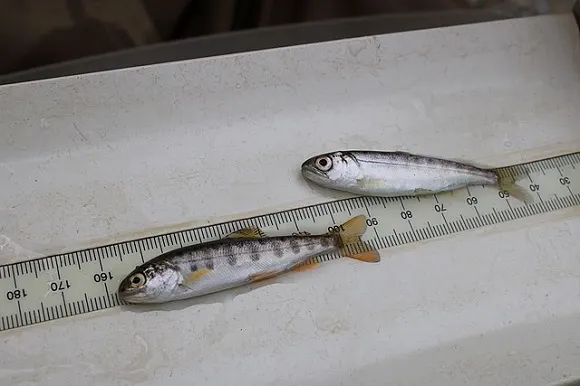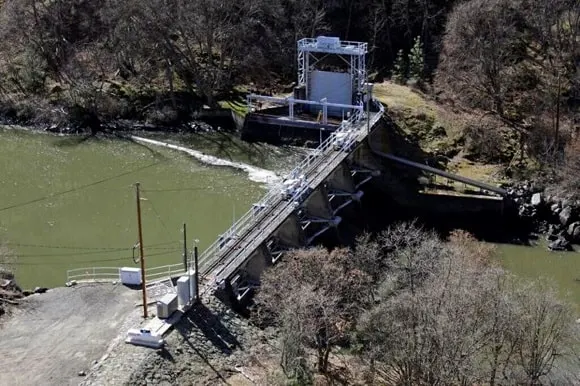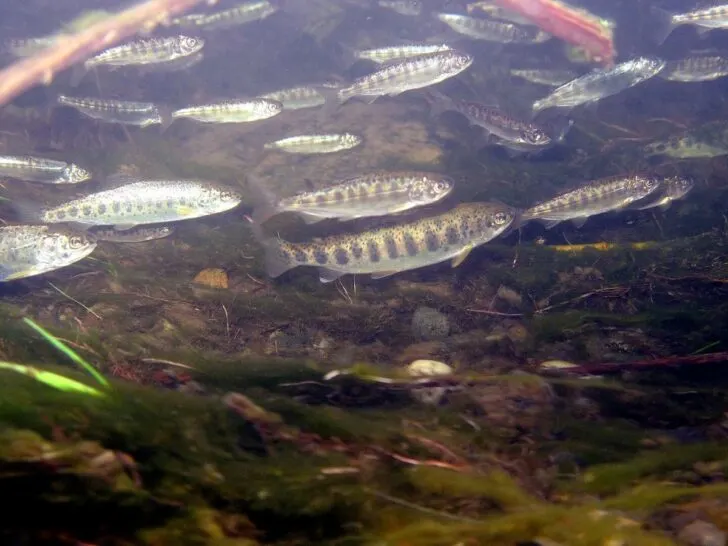The California Department of Fish and Wildlife (CDFW) has announced the presumed loss of a significant number of fall-run Chinook salmon fry due to gas bubble disease.
This incident occurred shortly after their release into the Klamath River from the Fall Creek Fish Hatchery in Siskiyou County, marking a somber moment for conservation efforts on the Klamath.
What Happened?
On February 26, the CDFW released approximately 830,000 fall-run Chinook salmon fry into Fall Creek, a tributary of the Klamath River, above the Iron Gate Dam.
These fry were the first to be released from the newly constructed Fall Creek Fish Hatchery, a $35 million state-of-the-art facility designed to bolster California’s commitment to restoring Chinook and coho salmon populations in an undammed Klamath River.
Tragically, a large number of these young salmon succumbed to gas bubble disease, a condition often linked to severe pressure changes and environmental trauma.
This disease is believed to have afflicted the salmon as they migrated through the tunnel of the Iron Gate Dam, an old piece of infrastructure slated for removal later this year.
The disease manifests physically in the fish, making it identifiable through monitoring equipment, which also recorded healthy coho and Chinook salmon coming from downstream of the dam.
The CDFW has clarified that the mass mortality event does not appear to be related to other water quality conditions in the Klamath River, such as turbidity or dissolved oxygen levels, which were deemed suitable in the days leading up to and following the release.
In response, the CDFW has decided to conduct all future salmon releases below the Iron Gate Dam until the problematic infrastructure is removed.
This strategy aims to mitigate the risk of similar incidents and improve the survival rates of hatchery-released salmon, which are vital for replenishing the species in the wild.
Despite this setback, the Fall Creek Fish Hatchery still houses approximately 3.27 million healthy fall-run Chinook salmon, with additional releases planned for later in the month.
The hatchery’s annual production goal is to raise and release 3.25 million fish, including 1.25 million fry, 1.75 million smolts, and 250,000 yearlings.
The surplus of fall-run Chinook salmon remaining in the hatchery is expected to help offset the losses incurred from this unfortunate event.
What Is Gas Bubble Disease?

Gas bubble disease (GBD) is a non-infectious condition affecting fish, amphibians, and aquatic invertebrates, caused by the supersaturation of gases (primarily nitrogen) in their environment, leading to an increase in dissolved gas pressure above ambient air pressure.
This condition results in the formation of gas bubbles within the tissues of affected organisms.
GBD can manifest in both chronic and acute forms, with symptoms ranging from disorientation and subcutaneous emphysema to severe embolism and high mortality rates.
The disease is particularly prevalent in environments with elevated partial pressures of nitrogen, such as spring or groundwater.
The Klamath Dam Removal Project

Alright, so how does this incident connect to the ongoing dam removal project on the Klamath?
The CDFW hasn’t made this connection, but the keywords in this regard are nitrogen and severe pressure change.
Correct me if I’m wrong here, but reservoirs created by dams tend to hold substantial amounts of nitrogen.
Now that the dams are being removed on the Klamath River, the reservoirs empty into the now open river, and with them all of their stored nitrogen.
Now, when all of that water and nitrogen passes through a narrow passage, like the Iron Gate tunnel, the concentration of said nitrogen is much higher, hence causing the increase in gas pressure. (Again, please correct me, should I be wrong!)
So yes, the hundreds of thousands of salmon fry died while migrating through that tunnel. But, in this case, it wasn’t the tunnel itself that killed them, but the abnormally high concentrations of nitrogen in the water there.
This caused me to question the CDFW’s decision to release the fry above the dam and tunnel.
According to various news reports, the dam removal project managers’ planning documents projected that several million tons of sediment would be flushed out from the reservoirs, increasing turbidity and decreasing dissolved oxygen levels in the river’s water for months to come.
Why, then, didn’t they project the unleashing of vast amounts of nitrogen as well? Clearly, the involved biologists must have been aware of that process taking place.
And if that was indeed the case, why did they then decide to release the salmon fry above the dam, knowing that the fish would have to migrate through the tunnel?
Why couldn’t they have released the fry downstream of the tunnel, like they plan to do next time?
Does anyone know the cost per hatchery-raised juvenile salmon? It can’t be cheap, can it?
Please don’t get me wrong, though! I think these dam removals are a great idea, as projects like these have shown how much a river system, and its fish populations, can benefit from such restoration efforts.
The long-term effects of removing such dams can be extremely positive for a river’s salmon and steelhead population!
However, a mishap like this one most likely increases concerns about river restorations and their impact on wildlife.
If this was a mistake or a calculated risk the CDFW was willing to take, I really don’t know. All I know is that this could have easily been avoided.
After all, the Klamath lost thousands and thousands of potential future adult chinook salmon thanks to this incident.
If the authorities are really concerned about the wildlife and the environment (and I believe they really are, for the most part), a thing like this shouldn’t have happened if you ask me!


Leave a comment